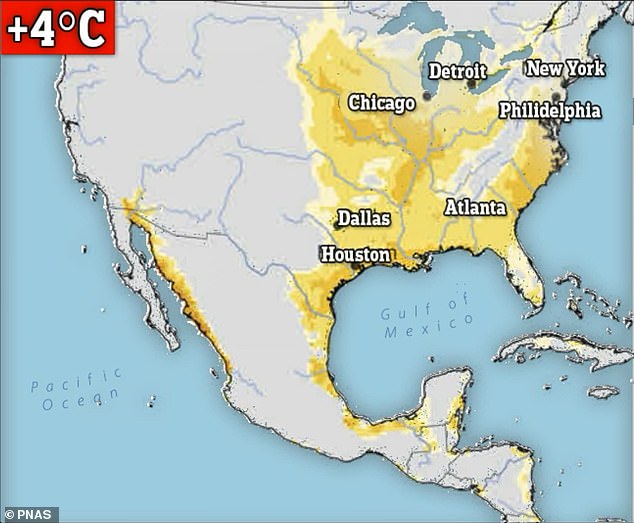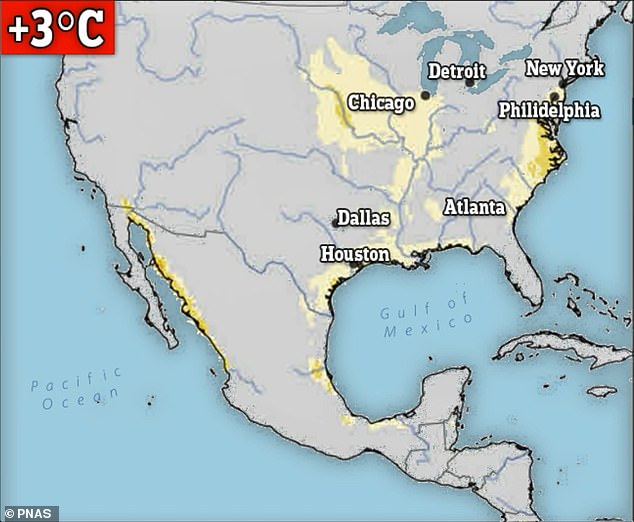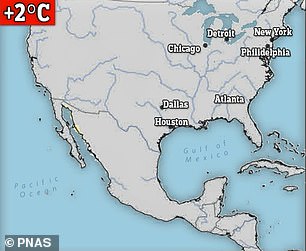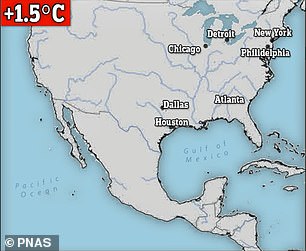Time to move? US East Coast and Middle American homes could be too hot to live in by 2100, scientists warn
>
Scientists have warned that the US East Coast and Central America could become uninhabitable by 2100 due to rising global temperatures.
A startling study found that areas from Florida to New York and Houston to Chicago would see deadly combinations of heat and humidity if global temperatures rose 5.4 degrees Fahrenheit above pre-industrial levels.
More than 300 million people live in this region of the country.
So-called “humid temperatures” and extreme heat have led to cardiovascular and respiratory disorders, but warming discovered by a University of Pennsylvania-led team could kill about 200,000 Americans a year.

The startling study found that areas from Florida to New York and Houston to Chicago would see a deadly combination of heat and humidity if global temperatures rose 5.4 degrees Fahrenheit above pre-industrial levels.

Scientists warn that the US East Coast and Central America could become uninhabitable by 2100 due to rising global temperatures. Above, a map of areas likely to see between 3 and 56 hours of life-threatening temperatures per year, if average global temperatures rise 4 degrees Celsius.

Above, a map of the regions likely to see between 3 and 24 scorching hours of life-threatening temperatures annually, if average global temperatures rise by 3 degrees Celsius.
“It’s very concerning,” study co-author Matthew Huber from Purdue University in Indiana, USA, told Reuters. “It will send a lot of people to emergency medical care.”
Older people, children and those with health problems are particularly at risk, but experts fear that billions of people around the world could also be at risk as the climate warms.
“As people become warmer, they sweat, and more blood is pumped to their skin so they can maintain core temperatures by losing heat to the environment,” said study co-author Larry Kinney.
“At certain levels of heat and humidity, these adjustments are no longer sufficient, and the body’s core temperature begins to rise.
“This is not an immediate threat, but it requires some form of relief.
“If people don’t find a way to cool down within hours, it can lead to heat exhaustion, heat stroke, and stress on the cardiovascular system that can lead to heart attacks in frail people.”


“Humid temperatures” and extreme heat can lead to cardiovascular and respiratory problems, but the warming revealed by the new study could kill about 200,000 Americans annually. Lower elevations (above) would avoid the United States, but would still harm developing countries near the equator.

The summer of 2023 was the hottest on Earth since global records began in 1880, according to NASA’s Goddard Institute for Space Studies. June, July and August combined were 0.41°F warmer than any other summer in NASA’s record and 2.1°F warmer than the average between 1951 and 1980.
The summer of 2023 was the hottest on Earth since global records began in 1880, according to scientists at NASA’s Goddard Institute for Space Studies (GISS) in New York.
June, July and August combined were 0.41 F warmer than any other summer in NASA’s record and 2.1 F warmer than the average summer between 1951 and 1980.
NASA shared that August alone was 2.2 degrees Fahrenheit warmer.
The average annual temperature has increased by 0.3 F per decade in the New York City area, while summer temperatures in Florida have increased by about 1.0 F since 1950.
Those living in the Chicago area have experienced warmer winters, with last February being 7.6 degrees Fahrenheit warmer than it was in 1970.
The average summer temperature in Houston increased by 4.2 degrees from 1970 through 2022.
Researchers in the new study modeled global temperature increases of between 2.7 F and 7.2 F — a worst-case scenario where warming begins to accelerate.
Their goal was to identify areas on Earth where warming could raise temperature and humidity levels beyond human limits.
Since the beginning of the Industrial Revolution — when humans began burning fossil fuels in machines and factories — temperatures around the world have risen by about 1.8 F.
What is particularly worrying is that many of the worst-affected areas are low- to middle-income countries that likely do not have access to air conditioning, the researchers said.
(Tags for translation)dailymail
